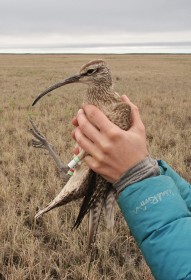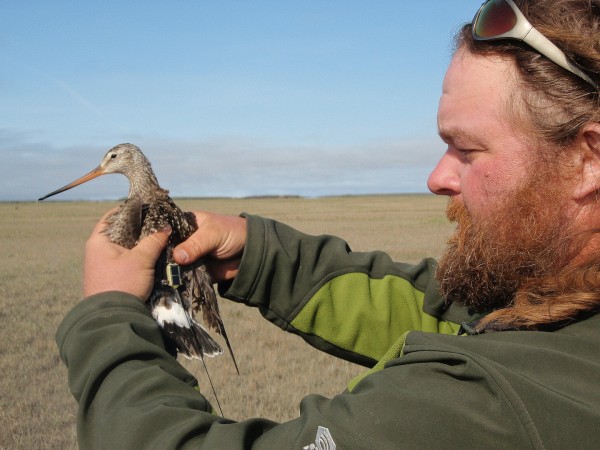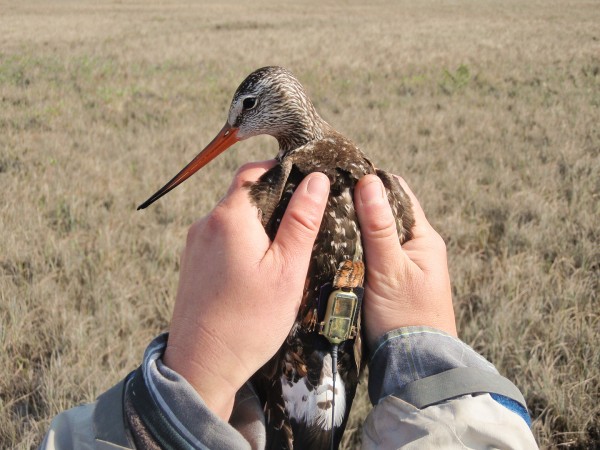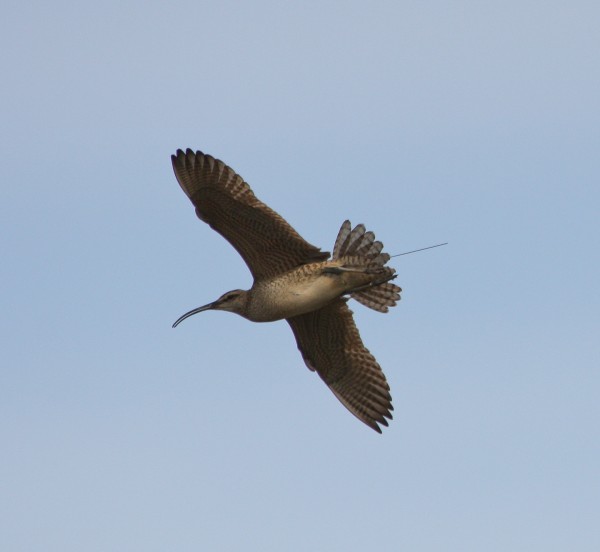CCB collaborates with Canadian Wildlife Service on Arctic Shorebirds
Camellia “Catch Me If you Can!!” Aug 16
August 16, 2013Camellia In Flight Over Larkspur Aug 18 4PM
August 19, 2013

Whimbrel in hand after banding on the breeding grounds of the Mackenzie Delta. Photo by Fletcher Smith.
In mid-July, Fletcher Smith returned from a 6-week stint in the Canadian arctic where he was assisting in operating a shorebird base camp on the Mackenzie River Delta in collaboration with the Canadian Wildlife Service. The camp is part of both the Arctic Shorebird Demographic Network (ASDN) and the Arctic Program for Regional and International Shorebird Monitoring (Arctic PRISM) The overarching objectives of these programs are to measure demographic parameters of breeding shorebirds, such as adult survivorship and productivity, to estimate population size and trends in Arctic shorebirds. This information is extremely hard to gather for shorebirds and the network of sites gathering this information spans the entire Arctic. The focal species in the Mackenzie River Delta include Red-necked Phalarope, Semi-palmated Sandpiper, Pectoral Sandpiper, and Whimbrel. During the 2013 season, the Mackenzie Delta crew was able to find and monitor over 100 shorebird nests, capture and band nearly 100 shorebirds, deploy all 6 satellite transmitters on Whimbrels and Hudsonian Godwits, and deploy 15 geolocators on Semi-palmated Sandpipers, adding up to a successful season by any measure.

Fletcher Smith with Hudsonian Godwit after transmitter attachment. Photo by CCB.
The collaborative satellite tracking project has been a tremendous success in providing useful information to conservation. Prior to the tracking of the Mackenzie River Delta Whimbrels, very little was known about the broader life cycle of these birds. A Whimbrel named “Hope” was the only previous connection from the Atlantic coast stopover areas to the Mackenzie Delta. “Hope” was tagged in Virginia and migrated to the Mackenzie Delta for four breeding seasons, using Virginia as a staging ground both in spring and fall migrations. During the 2012 breeding season, four Whimbrels were tagged in the Mackenzie Delta and all four migrated to eastern staging grounds before wintering in Brazil. The three Whimbrels tagged in 2013 took the same basic route, flying from the Mackenzie Delta to Atlantic Canada. They staged within in Atlantic Canada for approximately 2-3 weeks before undertaking the non-stop 4,000 plus mile flight to northern South America where they will spend the winter. The majority of whimbrels winter in or near the Gulf of Maranhao in Brazil.

Hudsonian Godwit with 5-gram satellite transmitter. Photo by Fletcher Smith.
No Hudsonian Godwits have ever been satellite tagged, so the movements of these birds will be particularly interesting to scientists involved in the study. One of the Hudsonian Godwits has migrated from James Bay/Hudson Bay staging grounds to the Orinoco River in Venezuela. This was a 3,900 mile non-stop journey. The Whimbrels and Godwits can be tracked at Wildlifetracking.org.

Whimbrel with transmitter in flight. Photo by Fletcher Smith.
Written by
Fletcher Smith | fmsmit@wm.edu | (757) 221-1617
August 16, 2013
Updated: September 28, 2013



